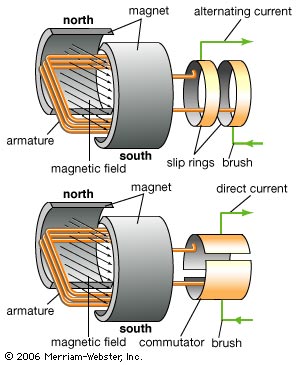AC vs DC
Electricity flows in
two ways: either in an alternating current (AC)
or in a direct current (DC). Electricity or
'current' is nothing more than
moving electrons along a conductor, like a wire, that have been
harnessed for
energy. Therefore, the difference between AC and DC has to do with the
direction in which the electrons flow. In DC, the electrons flow
steadily in a
single direction, or "forward." In AC, electrons keep switching
directions, sometimes going "forward" and then going "backward.
A
magnetic field near a wire causes
electrons to flow in a single direction along the wire, because they
are
repelled by the negative side of a magnet and attracted toward the
positive
side. This is how DC power from a battery was born, primarily
attributed to
Thomas Edison's work.
AC generators gradually replaced Edison's DC battery system because AC is safer to transfer over the longer city distances and can provide more power. Instead of applying the magnetism along the wire steadily, scientist Nikola Tesla used a magnet that was rotating. When the magnet was oriented in one direction, the electrons flowed towards the positive, but when the magnet's orientation was flipped, the electrons turned as well.

